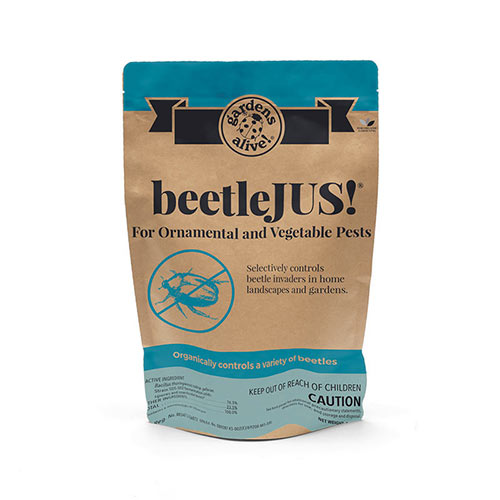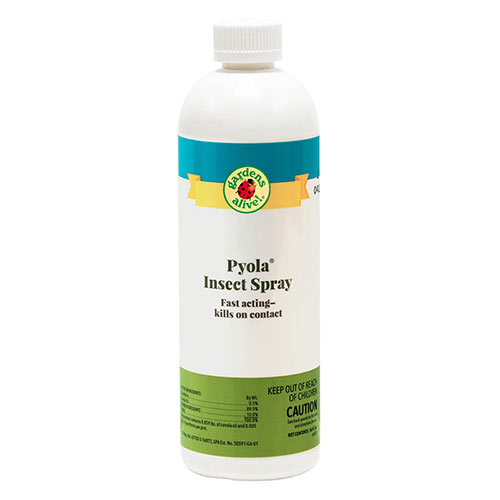What's Eating my Garden? And are the 'Leftovers' Safe?
-
Helpful Products from Gardens Alive!
-
 beetleJUS!®Concentrate for Ornamental and Vegetable Pest Control
beetleJUS!®Concentrate for Ornamental and Vegetable Pest Control -
 Pyola® Insect Spray
Pyola® Insect Spray
Q. In an email with the subject line ''voles', Vicki in Madison, Alabama writes: "I believe that my garden has recently been visited by these pests. The question is: do I throw away all the veggies they have taken a chunk of? Or try to salvage the parts that may still be consumable?"
A. That strongly depends on what's actually doing the eating. For instance, if a slug takes a chunk out of a big bell pepper, I would certainly cut away the bad edges and eat the rest. Same for rabbits, deer, tomato hornworms and other hungry, hungry caterpillars.
But before we move on to discuss the damaged produce you should NOT eat, let me say that this does not sound like the voles Vicki suspects. Voles do eat a lot of plant material, but the damage they do is at or below ground level. They don't climb, and they're not known for taking 'bites' out of things—they devour entire root systems and underground plant parts; especially Spring bulbs and the roots of hostas.
Back to the topic at hand; damaged produce that people should not eat: Anything that was attacked by vermin like mice, rats or raccoons. There's a real risk of disease, especially from racoons, whose poop can be extremely dangerous to humans, whether you inhale the dried material or touch it fresh. (Yet another reason to always wear gloves in the garden.)
Now, to try and figure out exactly what IS doing this specific eatin', we contacted Vicki and asked her to describe the damage. She writes: "I first noticed that my tomatoes were getting eaten about two to three feet up, then the green peppers. Whatever it is did not touch the jalapenos but did take one bite of a hot banana pepper and never bothered that again. It hasn't bothered the cucumbers.
"I have a raised bed vegetable garden that's about 18 inches high framed with cement blocks and filled with sand, compost, and bagged garden soil. I do have some sweet potatoes taking over now that the tomatoes and cucumbers are almost done. I thought that the height meant that it would not be rabbits—that and the fact that the droppings were on top of exposed leaves…".
'Droppings?' What droppings??
She explains that later on. Ah; here we go: "I did notice droppings; what I think is scat of some kind; a lot of it! It does not look like mouse droppings—more like rabbit in that it is round and small—but it is black and not smooth; more of a rough texture. I was able to just blow it off the leaves I found it on. Could this be bats? Do they eat veggies?!"
Ha! Bats are carnivores; they eat night-flying insects, especially big tasty moths. They don't eat crops; they protect them. (And I should know because I'M Batman!)
The culprit? I first thought slugs, as they can climb high (one wet year I found them feasting on the tassels of my six-foot high sweet corn!); and they often go unsuspected because they do their damage late at night. I suggest Vicki crack open a beer at sunset, pour it into containers like old margarine tubs and check them in the morning. If they're filled with dead drunken slugs, the miserable mollusks are at least part of the problem.
But that's NOT slug scat she sees; right?
No. Now; apologies in advance for the following poopy paragraphs.
Rabbit poop is pellet-shaped and light in color—and again, they're ground feeders that can't climb. Raccoon poop looks quite a bit like cat poop; not like what's she's describing. Mouse and rat poop is small and somewhat rod-shaped; very distinctive-looking. "Round" makes me think of deer; deer scat is round, black, abundant, and looks like a pile of little cannon balls. But each deer eats many pounds of food a day; they devour entire plants rather than take bites.
That leaves tomato hornworms. These are the biggest caterpillars in North America, but often escape detection because their natural coloring blends perfectly with the branches and leaves of tomato plants—and the rampant growth of tomatoes offers many excellent hiding spots for the beasts.
AND they also attack pepper plants—but not cucumbers, so it matches all of the evidence. Many gardeners first notice the hornworms' distinctive 'frass' at the base of the plants they're munching on before they see the actual caterpillar. It looks a little bit like miniature deer poop and, as Vicki notes, there's a lot of it. Oh, and I should also mention that her suspect voles would have decimated the sweet potatoes she mentions; it's one of their favorite targets.
So: Vicki should
1) Check for slugs. If they are present, get one of the newer slug baits whose active ingredient is iron phosphate.
2) Carefully inspect the plants throughout the season for huge green caterpillars. Look at pictures of hornworm frass online to make a positive ID. If they're guilty, get the old original form of Bt (BTK) and spray it on the plants. (Or just get it and spray the plants every three or so proactively.)
As always, the products we mention are harmless to you and other living things other than their intended target. Iron phosphate slug bait only kills slugs; and BTK only affects caterpillars that feed on the sprayed plants.
A. That strongly depends on what's actually doing the eating. For instance, if a slug takes a chunk out of a big bell pepper, I would certainly cut away the bad edges and eat the rest. Same for rabbits, deer, tomato hornworms and other hungry, hungry caterpillars.
But before we move on to discuss the damaged produce you should NOT eat, let me say that this does not sound like the voles Vicki suspects. Voles do eat a lot of plant material, but the damage they do is at or below ground level. They don't climb, and they're not known for taking 'bites' out of things—they devour entire root systems and underground plant parts; especially Spring bulbs and the roots of hostas.
Back to the topic at hand; damaged produce that people should not eat: Anything that was attacked by vermin like mice, rats or raccoons. There's a real risk of disease, especially from racoons, whose poop can be extremely dangerous to humans, whether you inhale the dried material or touch it fresh. (Yet another reason to always wear gloves in the garden.)
Now, to try and figure out exactly what IS doing this specific eatin', we contacted Vicki and asked her to describe the damage. She writes: "I first noticed that my tomatoes were getting eaten about two to three feet up, then the green peppers. Whatever it is did not touch the jalapenos but did take one bite of a hot banana pepper and never bothered that again. It hasn't bothered the cucumbers.
"I have a raised bed vegetable garden that's about 18 inches high framed with cement blocks and filled with sand, compost, and bagged garden soil. I do have some sweet potatoes taking over now that the tomatoes and cucumbers are almost done. I thought that the height meant that it would not be rabbits—that and the fact that the droppings were on top of exposed leaves…".
'Droppings?' What droppings??
She explains that later on. Ah; here we go: "I did notice droppings; what I think is scat of some kind; a lot of it! It does not look like mouse droppings—more like rabbit in that it is round and small—but it is black and not smooth; more of a rough texture. I was able to just blow it off the leaves I found it on. Could this be bats? Do they eat veggies?!"
Ha! Bats are carnivores; they eat night-flying insects, especially big tasty moths. They don't eat crops; they protect them. (And I should know because I'M Batman!)
The culprit? I first thought slugs, as they can climb high (one wet year I found them feasting on the tassels of my six-foot high sweet corn!); and they often go unsuspected because they do their damage late at night. I suggest Vicki crack open a beer at sunset, pour it into containers like old margarine tubs and check them in the morning. If they're filled with dead drunken slugs, the miserable mollusks are at least part of the problem.
But that's NOT slug scat she sees; right?
No. Now; apologies in advance for the following poopy paragraphs.
Rabbit poop is pellet-shaped and light in color—and again, they're ground feeders that can't climb. Raccoon poop looks quite a bit like cat poop; not like what's she's describing. Mouse and rat poop is small and somewhat rod-shaped; very distinctive-looking. "Round" makes me think of deer; deer scat is round, black, abundant, and looks like a pile of little cannon balls. But each deer eats many pounds of food a day; they devour entire plants rather than take bites.
That leaves tomato hornworms. These are the biggest caterpillars in North America, but often escape detection because their natural coloring blends perfectly with the branches and leaves of tomato plants—and the rampant growth of tomatoes offers many excellent hiding spots for the beasts.
AND they also attack pepper plants—but not cucumbers, so it matches all of the evidence. Many gardeners first notice the hornworms' distinctive 'frass' at the base of the plants they're munching on before they see the actual caterpillar. It looks a little bit like miniature deer poop and, as Vicki notes, there's a lot of it. Oh, and I should also mention that her suspect voles would have decimated the sweet potatoes she mentions; it's one of their favorite targets.
So: Vicki should
1) Check for slugs. If they are present, get one of the newer slug baits whose active ingredient is iron phosphate.
2) Carefully inspect the plants throughout the season for huge green caterpillars. Look at pictures of hornworm frass online to make a positive ID. If they're guilty, get the old original form of Bt (BTK) and spray it on the plants. (Or just get it and spray the plants every three or so proactively.)
As always, the products we mention are harmless to you and other living things other than their intended target. Iron phosphate slug bait only kills slugs; and BTK only affects caterpillars that feed on the sprayed plants.
-
Helpful Products from Gardens Alive!
-
 beetleJUS!®Concentrate for Ornamental and Vegetable Pest Control
beetleJUS!®Concentrate for Ornamental and Vegetable Pest Control -
 Pyola® Insect Spray
Pyola® Insect Spray







 Gardens Alive! & Supplies
Gardens Alive! & Supplies




